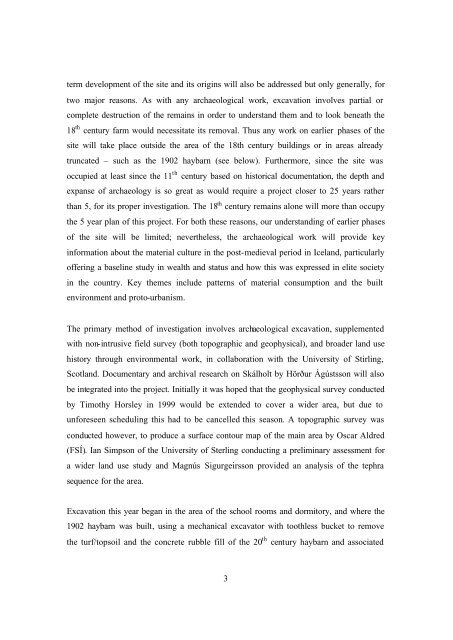Skáholt 2002 - Nabo
Skáholt 2002 - Nabo
Skáholt 2002 - Nabo
You also want an ePaper? Increase the reach of your titles
YUMPU automatically turns print PDFs into web optimized ePapers that Google loves.
term development of the site and its origins will also be addressed but only generally, for<br />
two major reasons. As with any archaeological work, excavation involves partial or<br />
complete destruction of the remains in order to understand them and to look beneath the<br />
18 th century farm would necessitate its removal. Thus any work on earlier phases of the<br />
site will take place outside the area of the 18th century buildings or in areas already<br />
truncated – such as the 1902 haybarn (see below). Furthermore, since the site was<br />
occupied at least since the 11 th century based on historical documentation, the depth and<br />
expanse of archaeology is so great as would require a project closer to 25 years rather<br />
than 5, for its proper investigation. The 18 th century remains alone will more than occupy<br />
the 5 year plan of this project. For both these reasons, our understanding of earlier phases<br />
of the site will be limited; nevertheless, the archaeological work will provide key<br />
information about the material culture in the post-medieval period in Iceland, particularly<br />
offering a baseline study in wealth and status and how this was expressed in elite society<br />
in the country. Key themes include patterns of material consumption and the built<br />
environment and proto-urbanism.<br />
The primary method of investigation involves archaeological excavation, supplemented<br />
with non-intrusive field survey (both topographic and geophysical), and broader land use<br />
history through environmental work, in collaboration with the University of Stirling,<br />
Scotland. Documentary and archival research on Skálholt by Hörður Ágústsson will also<br />
be integrated into the project. Initially it was hoped that the geophysical survey conducted<br />
by Timothy Horsley in 1999 would be extended to cover a wider area, but due to<br />
unforeseen scheduling this had to be cancelled this season. A topographic survey was<br />
conducted however, to produce a surface contour map of the main area by Oscar Aldred<br />
(FSÍ). Ian Simpson of the University of Sterling conducting a preliminary assessment for<br />
a wider land use study and Magnús Sigurgeirsson provided an analysis of the tephra<br />
sequence for the area.<br />
Excavation this year began in the area of the school rooms and dormitory, and where the<br />
1902 haybarn was built, using a mechanical excavator with toothless bucket to remove<br />
the turf/topsoil and the concrete rubble fill of the 20 th century haybarn and associated<br />
3
















